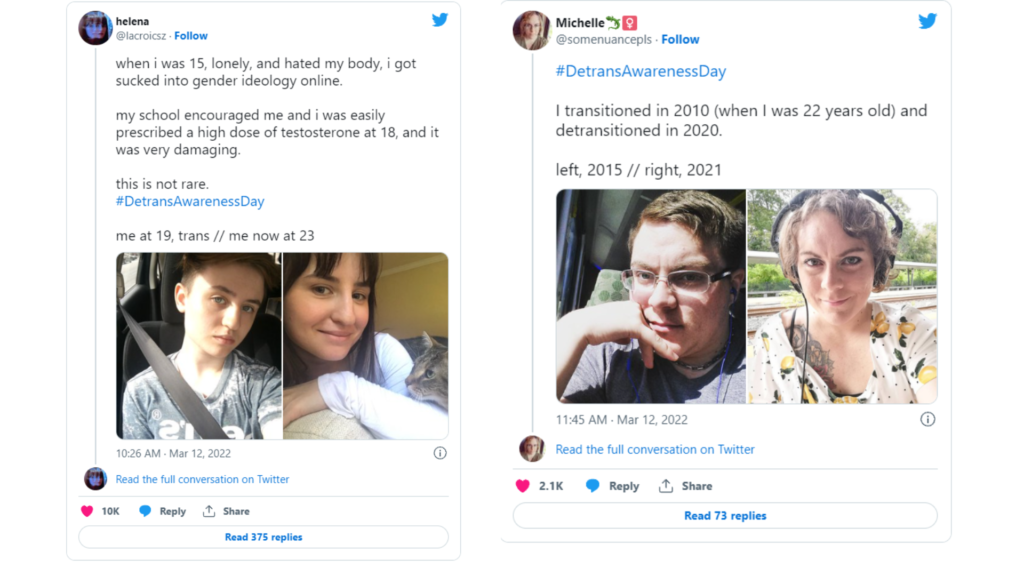There is a sad and broken narrative that promotes gender-affirming treatment as a solution for those struggling to understand their true biological identity. Advocates for these kinds of treatments have grounded their arguments around a false and deceptive sense of empathy. They encourage youth to seek gender-affirming treatment as a way of greater self-expression and to lay claim to who they ‘truly’ are as an individual. Though, how long does their empathy last once teenagers start to see the devastating effects that these medical treatments have on their bodies? What about the alarming suicide rates before and after surgery? The solution is not to affirm what they are not; but to confirm the reality by which they were born into. If we truly respected those in the LGTBQ community, we would be teaching them to embrace the reality of who they truly are, including their physical bodies.
The substance of the LGBTQ narrative is best represented by organizations like LGTBQ and ALL. The problem is that they offer a disconcerting amount of information about how gender-affirming surgeries actually work. This is obvious by the lack of understanding they provide on the health risks involved. While LGBTQ and ALL do mention infections and excessive bleeding (the same risks involved in any other surgical operation); they fail to provide the more serious consequences that patients experience after their surgeries. Rather, most of their information is in support of an article by the Columbia University Irving Medical Center (UCIMC) claiming that gender-affirming treatments ‘save lives’. However, there is not a single piece of factual evidence in their article proving that claim. Instead, UCIMC shares ways of doing just the opposite.
They encourage parents to allow their children to use made-up pronouns at home and to praise them for doing so. They believe that this will help children feel more confident in using their gender identities in public. In other words, UCIMC is teaching parents to let their children freely alter their reality. This is a terrible way for children to approach real-life problems which will only bring them harm in the future. That they can somehow tangibly change their biological sex through the distortion of language or by medical treatment is a false answer for their confusion. Ideally, health organizations should be teaching them how reality is the very environment by which our human nature operates in and best thrives under. It can never be changed to accommodate those who disagree with it. Saying that gender is a ‘social structure’ does not in any way change one’s biological sex. It only further disconnects people from their reality.
There are indeed serious biological consequences for those attempting to change that reality. UCIMC, along with many other LGBTQ supportive organizations, introduces families to puberty blockers. Pubertal suppression gives children the option to delay their natural growth so that they can experiment with other gender-affirming treatments. While puberty blockers may be partly reversible, it can damage teenagers’ chances of fertility. What is irreversible though, are gender-affirmative surgeries. After these surgeries, women are no longer fertile and have zero chance of biological reproduction due to the hysterectomy and oophorectomy they must undergo as part of the procedure. Even hormone therapy can harm women’s chances of fertility. This has been noted to be an ethical violation of the World Professional Association for Transgender Health and of the Endocrine Society for advocate counseling. Unfortunately, these details are often left out in the LGBTQ narrative, including the mental health problems this community faces
The Centre for Suicide Prevention reported that 22 – 43% of transgender people have attempted suicide in their lifetime and that two-thirds of transexual youth have reported recent self-harm. On top of that, the suicide rate of those who underwent gender-affirming surgeries increased to 20 times that of their peers within ten to 15 years post-surgery. With up to 20% of transexual youth experiencing regrets about their sex change, it is clear that those in the LGBTQ community are facing larger problems of mental health. This information allows us to have a more honest view of the harm that LGBTQ advocates have had on our youth. From there, we can have a more fruitful discussion of the remedy for this generational crisis.
There are some practical ways to slow down and provide proper support. For those of you who are considering gender-affirmative surgeries or treatment: wait. Take time to sit down and research the health risks involved in going through with this operation. Talk to someone, perhaps a counselor or doctor, that will walk you through this decision. More importantly, avoid head-nodding specialists who are quick to prescribe gender-affirming treatment. Find someone who will tell you the truth. For those in positions of policymaking, education, and health; an embracing and truthful perspective must be reflected through the organization’s mission and staff. For the rest of us, we must be willing and ready to share the truth courageously and courteously. We must model good and inviting behavior that will help start the conversation. It is time for those in the LGBTQ community to understand that reality is what unites us as one community. You and I were born with a right beauty.
Additional Resources
Misleading Statistics Advocating for Gender-Affirming Surgeries
